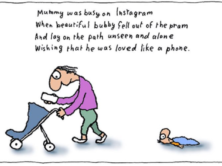
The Guardian is the Observer's sister newspaper.(Credit: The Guardian, screenshot, highlight added)
What happened to Jared Diamond’s libel lawsuit where he was sued by two Papua New Guinea tribesmen in 2009? Diamond falsely claimed in an article by Robin McKie published in The Observer on Jan. 5, 2013, that the case was dismissed. In fact, as documents show, the case was voluntarily withdrawn without prejudice and is still very much alive.
McKie discusses iMediaEthics’ investigation into Diamond’s now infamous New Yorker article about tribal warfare, in his approximately 3,500-word review of Diamond’s new book, “The World Until Yesterday: What Can We Learn from Traditional Societies?”
McKie’s erred in his review when allowing Diamond to mislead readers about the state of the libel lawsuit against him. This error is followed by other errors and only some are listed below in an open letter to McKie where I ask for corrections and clarifications in The Observer.
In 2009, iMediaEthics (named StinkyJournalism then) first revealed the $10 million defamation litigation against Diamond for his New Yorker tale, “Annals of Anthropology: Vengeance Is Ours: What can tribal societies tell us about our need to get even?” in our investigation of Diamond falsely naming people and tribes he never researched or met as warriors who were responsible for at least 30 deaths.
McKie mistakenly wrote, “Diamond wrote up the story for the New Yorker in 2009” when, in fact, it was published in the April 21, 2008 issue of the magazine. Read more about McKie’s errors below. An almost identical email went to Mr. McKie on Jan. 6 and 7 but iMediaEthics has had no response.
OPEN LETTER TO ROBIN MCKIE, UK THE OBSERVER:
Dear Mr. McKie,
I am very sorry you did not contact me before publishing misleading and incorrect information in your Jan. 5, 2013 report, “Jared Diamond: what we can learn from tribal life.”
You wrote:
“Several years ago, Diamond met a tribesman called Daniel Wemp who said he had organised a clan war in New Guinea to avenge the death of an uncle. After three years, and 29 deaths, Wemp’s target – a man called Isum Mandingo – was left paralysed in an attack. Diamond wrote up the story for the New Yorker in 2009 – and found himself at the receiving end of a $10m lawsuit.
“An investigation by Rhonda Roland Shearer – the widow of the evolutionary biologist Stephen Jay Gould and a director of a website called StinkyJournalism – alleged that the New Yorker article was riddled with errors; that Wemp had not organised the clan war and that Mandingo had not been injured. It was also claimed that Wemp was now living in fear of his life because of Diamond’s article. Hence the lawsuit. For their part, both Diamond and David Remnick, the editor of the New Yorker, vigorously denied the allegations. Their story was backed by careful notes that had been taken at the time by Diamond, while his text had been carefully scrutinised by one of the magazine’s best fact checkers, Remnick added.
“The case caused a flurry among science journals but has since fizzled out. Diamond blinks and looks pained when I mention the name Rhonda Shearer. “A distinctive person about whom I shall refrain from commenting,” he mutters. “That was the first and only time I have been sued. I am happy to say the case was dismissed.” However, there is no mention of the Wemp tale, although highly relevant to Diamond’s thesis, in The World Until Yesterday. Caution appears to have won the day.”
1. There are many problems in this statement above, including that you allowed Diamond to falsely imply that the court dismissed the lawsuit against him. See attached. The lawyers for both sides made a stipulation that the case be dismissed without prejudice and without costs. Diamond and the New Yorker agreed to this as they, no doubt, did not want more damaging papers to be filed in New York and knowing full well that Wemp and Mandingo would be empowered by this stipulation to sue in another jurisdiction. To have the case withdrawn without prejudice is completely different than a case being dismissed by the Court with prejudice. The reason why Wemp and Mandingo sought to withdraw the lawsuit was not based on lack of merit, but the fact their high-powered New York lawyer, Jack Litman, suddenly died, leaving them without representation or cash to hire another as they are poor tribesmen. They are working on filing another lawsuit now. Indeed, I just heard from one of their Papua New Guinea lawyers about this pending suit in the past week. The seven-year statute of limitations in Papua New Guinea allows them to file any time before April 2015.
.JPG)
See above. Detail from the stipulation document shows that the lawsuit was “withdrawn without prejudice.”
2. A second matter: In your piece, Diamond lied when he claims the Wemp/Mandingo lawsuit “was the first and only time I have been sued”? In his book, “The World Until Yesterday” he admits to three legal actions. He states on page 88, (emphasis mine) “in my lifetime I have become involved in three civil disputes-with a cabinet maker, with a swimming-pool contractor, and with a real estate agent.” Diamond obviously lies by omission in the book as he does not mention the civil ligation against him in New York State Courts by Wemp and Mandingo. But he also lies by commission to you and your readers when saying he was only sued once in his lifetime, according to his own book.
3. The New Yorker and Diamond make very general defenses–stating that they fact checked the piece and used Diamond’s detailed notes. Yet your statement that Diamond and New Yorker “vigorously denied the allegations” implies that they have rebutted specific facts. They have never rebutted specific factual claims against them. (The only exceptions are feeble attempts by Diamond in Michael Balter’s report in Science, linked below)
Please see Diamond Affidavit to the New York Court. Diamond had no research list that justified his libelous factual accusations. His defence? He had one source he relied on, Daniel Wemp (his driver with a then, two-year high school education), who Diamond said, he believed at the time. He provided zero evidence of any independent verification of facts or research method or steps to test his allegations where he names real people and tribes of committing murder and mayhem in an unpublished war. Diamond’s New Yorker story reflects this shocking lack of sourcing.
See above, detail from Jared Dimaond’s affidavit. He claims the entire New Yorker article is based on his driver, plaintiff Daniel Wemp’s say so. Wemp denies telling the stories Diamond ultimately published.
Neither Diamond nor New Yorker fact checkers ever bothered to check maps and political districts (that Diamond got wrong) contact missionaries working in the area, check local government, police, court or hospital records, or contact the leading anthropology expert in this Wola area, Paul Sillitoe, or the Handa lawyer, PhD in law and tribesman Mako Kuwimb, who belongs to the Handa tribe featured in Mr. Diamond’s New Yorker report. After the Diamond reporting debacle, they wrote a definitive rebuttal of Diamond’s facts in a report, “Rebutting Jared Diamond’s Savage Portrait: What tribal societies can tell us about justice and liberty,” April 28, 2010.
Given the absence and Diamond’s admissions of faulty methods for his reporting both in NY State Court records and to Michael Balter’s report in Science, and the New Yorker report’s prima facie lack of sourcing, it is unfair that you did not criticize him or his methods, and did not give me or others, such as Wemp and Henep Isum fair opportunity to respond. Please see Balter’s report, if you have not already, that investigated my report and found no errors in my factual assertions, in addition to questioning Diamond’s flawed methods.
In the Science report, Diamond admits that he never contacted Henep Isum Mandingo, who Diamond described in the New Yorker as a murderous warrior and Omabl tribal leader when he was, in fact a village police officer, never in a wheelchair and not even a member of the Ombal tribe. (He is a Henep as his name indicates). What Diamond failed to inform you or his readers is that tribal warfare is high priority in law enforcement and is a capital crime in Papua New Guinea. Henep Isum was outraged by the injustice that his good name is out there in the world undefended and could potentially expose him to police enforcement when he was always a law-abiding citizen.
4. You wrote, “Daniel Wemp who said he had organised a clan war in New Guinea to avenge the death of an uncle. After three years, and 29 deaths, Wemp’s target – a man called Isum Mandingo – was left paralysed in an attack.” What is your source for this “fact”? This alleged fact is what is under dispute in court but you do not inform readers of this, and present it as plain fact. Wemp vehemently denies that he told Diamond these stories, yet you only represent Diamond’s and New Yorker’s “vigorous” denials.
Since you brought this controversy up in your review, and named me and the lawsuits, and the plaintiffs, I believe you had an obligation to fact check and to give me and the tribesmen and their lawyers a chance to respond.
Will you run speedy and transparent corrections and clarifications of the following?
a. You did not inform your readers that the tribesmen are filing another lawsuit. You only published Diamond’s statements, which are biased. Will you correct this error?
b. Diamond’s statement, about the lawsuit against him by the tribesmen being dismissed by the court, is misleading and wrong. Will you correct and clarify this error?
c. Diamond lied to you and in the book about the number of times he has been sued in civil disputes. Will you inform readers about Diamond’s contradiction cited in number 2 above and correct his false representation?
d. I believe it unfair and harmful that you presented my research as only unproven “claims” and “allegations” in a debate when New Yorker and Diamond are allowed to describe their research as “backed by careful notes that had been taken at the time by Diamond, while his text had been carefully scrutinised by one of the magazine’s best fact checkers.” Readers are therefore unaware that I vigorously assert and can provide abundant documentary evidence that supports my assertions that the story Mr. Diamond attributed to his World Wildlife Fund driver, Daniel Wemp, the single source for his story, is untrue. I could have provided evidence to you if you would have only acted fairly, and contacted me before publication. Will you give me an opportunity to respond and add a correction for this lapse?
e. You wrote, “Daniel Wemp who said he had organised a clan war in New Guinea to avenge the death of an uncle. After three years, and 29 deaths, Wemp’s target – a man called Isum Mandingo – was left paralysed in an attack.” What is your source for this “fact” that Wemp said these things? This alleged fact, a capital crime in PNG, is what is under dispute but you do not inform readers. Wemp vehemently denies that he told Diamond these stories. You did not report this fact. Will you correct this bias and error and give tribesmen a fair opportunity to respond?
f. You wrote “An investigation by Rhonda Roland Shearer – the widow of the evolutionary biologist Stephen Jay Gould and a director of a website called StinkyJournalism – alleged that the New Yorker article was riddled with errors; that Wemp had not organised the clan war and that Mandingo had not been injured.” This is untrue. I said Isum was not paralyzed in a wheel chair from an assassin’s spear that cut his spine as Diamond claimed. I would not have ever said he was not injured. I process Isum’s medical records that verify Isum had injuries from a non-life-threatening arrow wound that occurred while he was protecting his lands. Will you correct this error?
g. You wrote: I am “director of a website called StinkyJournalism.” This is incorrect. I am director of a not-for profit, Art Science Research Laboratory, that publishes an award-winning media ethics news site, called iMediaEthics, rebranded from StinkyJournalism more than one year ago. I am editor-in-chief and publisher of iMediaEthics. Will you correct this error?
h. Finally, Diamond is not an “anthropologist.” Yet the sub head (“The west’s dwindling connection with the natural world puts it in increasing peril, says the distinguished anthropologist in his new book. “) and the text of your report says he is one. (Diamond is wearing a bright red jacket, checked trousers, a carefully ironed shirt and a tie. With his moustache-less beard, he looks more like a renegade Amish preacher than a distinguished anthropologist.”) See his UCLA bio. Will you correct this error? .
I look forward to your timely response and a harmonious resolution. Thank you for your kind consideration.
Sincerely,
Rhonda R. Shearer
UPDATE: Jan. 8, 2013: 9:06PM EST: After not getting a response from McKie to our two emails (Sun, 06 Jan 2013 15:36:34 -0500, Mon, 07 Jan 2013 07:19:33 -0500), we wrote to the Guardian’s reader’s editor, at 9:15 AM today. We received a response by 9:21AM that their office would forward our inquiry to Stephen Pritchard, readers’ editor at the Observer. Mr. Pritchard, in turn, answered our email by 11: 34 AM. We are discussing corrections and will update the result.
UPDATE: Jan.10, 2013: 5:57AM EST: Stephen Pritchard, readers’ editor at the Observer, posted changes and a correction to the online version of McKie’s story by approximately 1:30PM EST yesterday. He said he would notify iMediaEthics today of the exact language for the Observer print edition that will be forthcoming. We will post further updates and an additional story to explain more. iMediaEthics is very impressed with the speed, seriousness of purpose and professionalism of Mr. Pritchard’s handling of this complex set of corrections in the face of our criticism.
UPDATE: Jan. 17, 2013: 8:43:AM EST: The readers’ editor at the Observer, Stephen Pritchard, as promised, ran a correction in Sunday’s print edition. In his Jan 13, 2013 column, “For the Record,” he writes:
“Our interview with biologist Jared
Diamond (New Review, last week,
page 8) described a libel suit against
him, which, we should clarify, was
brought by Papua New Guinea tribesmen
after he wrote an article in the
New Yorker in 2008 (not, as we said,
2009). He alleged that a tribesman
had organised a three-year clan war, in
which 30 (not, as we said, 29) had died
and one man left paralysed. We said
the case had been dismissed. In fact,
the action was withdrawn by mutual
consent. Further action is pending. We
also said that Rhonda Roland Shearer,
who investigated Diamond’s story, had
claimed that the paralysed man had not
been injured. This was incorrect. Her
iMediaEthics news website alleges he
was hurt in an unrelated attack. ”
We are preparing a story now that will further explain the Observer errors and corrections, the tribesmen response and reactions to the errors and their plans for “stopping Diamond’s lies .”
——————————————————————————————————————————————————————-
SUPREME COURT OF THE STATE OF NEW YORK COUNTY OF NEW YORK:
Henep Isum Mandingo and Hup Daniel Wemp, Plaintiffs,
Against,
Advance Publications, Inc. and Jared Diamond, Defendants.
See: Documents: Amended Complaint: Read the 30 page Lawsuit, Chronicles errors
Stipulation: Action Withdrawn without Prejudice
Standstill and Tolling Agreement
———————————————————————————————————————————————————————-

.JPG)





Thank you for this clarification. The statements made and the useful links to the documents of the NY Supreme Court raise more complex issues. The plaintiffs (Mandigo and Wemp) withdrew their action on 17 June 2010 (Standstill and Tolling Agreement), yet this website waited until 2013 to release the news. Diamond was clearly incorrect in stating that the action was dismissed. You claim that the tribesmen are preparing a second attempt at a lawsuit, but the evidence you provide is hearsay. How can you accuse the journalist McKie of failing to note hearsay which has not been documented elsewhere ?
@Peter Nigos, Thank you for writing. Indeed the documents we posted prove that the lawsuit was withdrawn, and McKie was wrong to allow Diamond to claim he was happy that the lawsuit against him was dismissed without checking if true. My open letter is in response to this and other errors, including the fact that I should have been contacted before publication to be fact checked. I would not have asked McKie to take my word for the fact that the plaintiffs want to refile and are working on it. If he would have contacted me, I would have provided –and still will–contact information for the plaintiff side in PNG so that he could do his own accurate reporting.